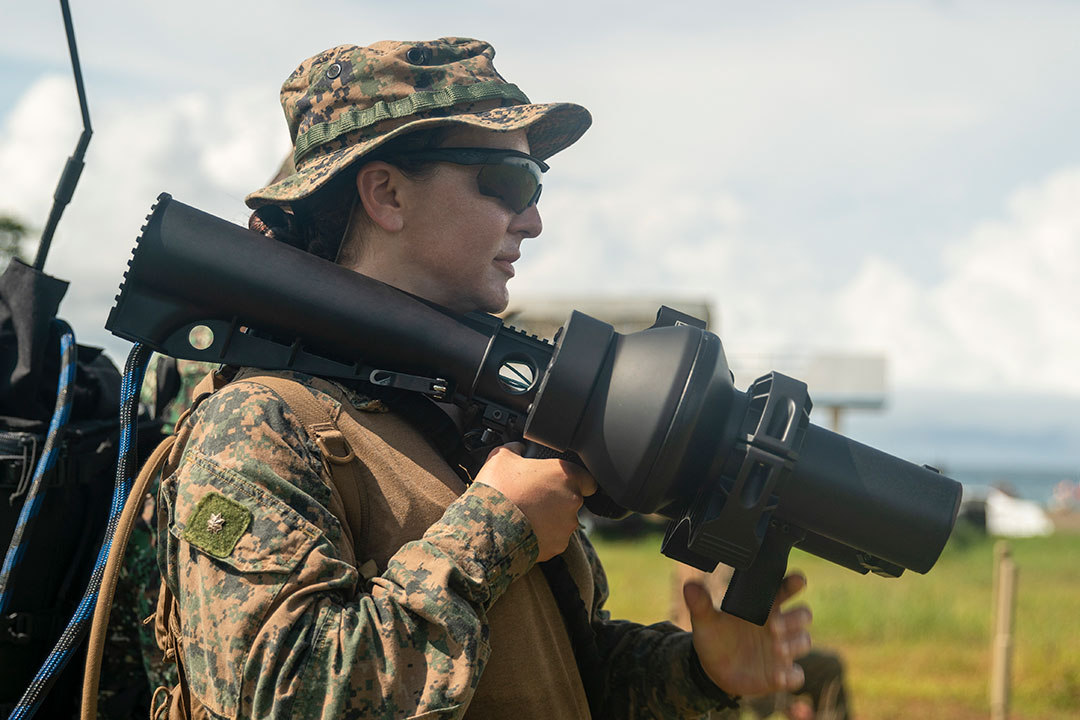U.S. Marines scan for simulated threats from the amphibious assault ship USS Boxer during a drill in the Pacific Ocean in July 2024. SGT. AMELIA KANG/U.S. MARINE CORPS
THE WATCH STAFF
As the surge of small Unmanned Aircraft Systems (sUAS) in battle poses a deadly challenge for modern military forces, the U.S. Marine Corps has announced it will equip deploying units with handheld prototype systems designed to counter the drones. “Unmanned aerial systems are a threat not just to infantry Marines, but to all Marines,” said Lt. Gen. Eric Austin, deputy commandant for combat development and integration.
Starting this summer, the prototypes will be fielded first to Marine Expeditionary Units and Marine Littoral Regiments, a Marine Corps official told Task & Purpose, an online defense news publication. “We’re excited to get that out with some of our next deploying units in order to protect them,” Austin said at the Navy League Sea-Air-Space 2025 conference at National Harbor, Maryland. However, citing security concerns, military officials are not disclosing the technologies that will be used.
“The technologies being fielded will allow Marines to detect, track, identify, and defeat adversary sUAS with both kinetic and non-kinetic means,” a Marine Corps article says. “These systems will be lightweight, easy-to-use, easy-to-train” and not tied to a specific military occupational specialty, meaning every Marine, regardless of training level, should be able to operate the systems with minimal instruction.
The small, dismounted units will augment a ground-based air defense program (GBAD), which targets larger threats, like missiles. But GBAD is “not always practical or available at scale to support individual unit operations,” according to a Marine Corps news release. Plus, GBAD units are more conspicuous and can draw enemy fire.
“It has been a long time, maybe since World War II, since a member of an infantry squad on the ground actually had to look up or over his shoulder, do anything other than clear an aircraft hot, or call in a medevac or something like that,” Lt. Gen. Benjamin Watson, the head of Marine Corps Training and Education Command, said at the Sea-Air-Space conference.

But agile, elusive and low-cost drones have reshaped the battlefield. In the Russia-Ukraine war, both sides have used small UAS with devastating effect. “Drones kill more soldiers on both sides than anything else,” Ukrainian military officials said in May 2024. They can be used for surveillance, precision strikes, electronic warfare or first-person-view (FPV) kamikaze attacks.
“So it is a different way of thinking, and it harkens back to the early ’90s … that kind of Cold War era where we actually trained small units in things like small unit defense against air attack,” Watson said, “and we put a lot more focus in the camouflage covering, concealment, with an eye toward who’s looking at us from above, not just who’s looking at us through their sites on the ground on the other side of the battlefield.”
Among other recent counter-UAS programs being adopted by the Marine Corps is the Marine Air Defense Integrated System (MADIS). The mobile platform, mounted on joint light tactical vehicles, offers a defense against small drones, helicopters and other low-flying threats. Working alongside MADIS is the Epirus Leonidas, a high-power microwave system that can disable several unmanned aerial vehicles at the same time, making it the go-to technology when enemies deploy drone swarms.
The military also has moved to harden its bases against drone attacks. In March, the Corps awarded a $642 million, 10-year contract to Anduril to install and maintain non-kinetic counter-UAS systems to protect Marine bases and other fixed sites.
The selection of the handheld prototype systems came after a yearlong review and a fly-off that tested various systems in September 2024, officials said. The Marine Corps repurposed money from other programs to field the prototypes, Austin said.
In addition to fielding new defenses, the Corps also has established an attack drone team to teach other Marines about new ways to use FPV drones based on lessons learned in the Russia-Ukraine war. “Someone has got to be the best in any organization and then have the best knowledge to teach it,” Col. Scott Cuomo, head of the Weapons Training Battalion in Quantico, Virginia, told Task & Purpose, an online portal that caters to service members and veterans.

